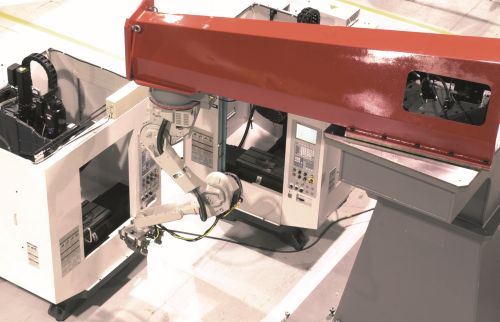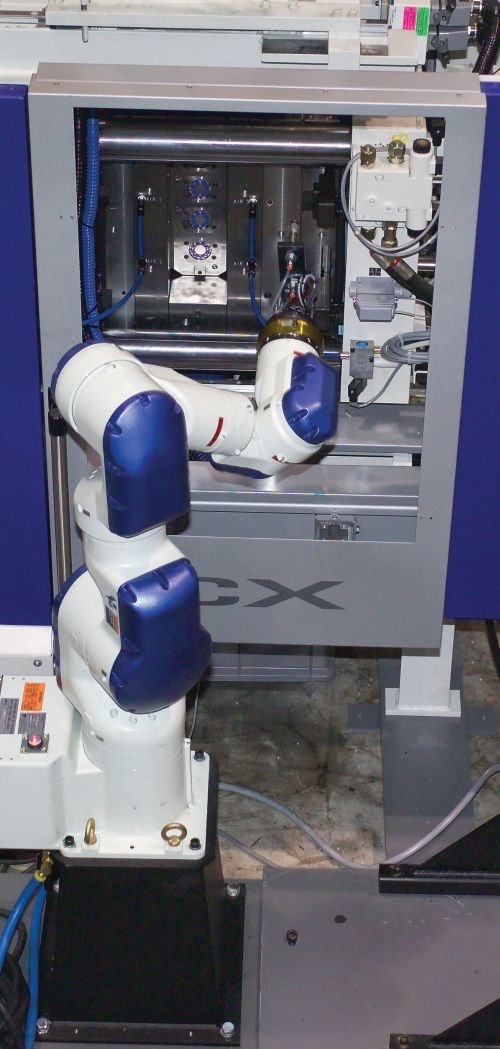Adding Value with Robotics
A robot may not directly make the final part, but it can add value to the overall process, if its use is properly planned and executed.
The moldmaking industry serves a myriad of markets and applications for which industrial robotics can be considered, including machining (EDM, laser, milling and more), inspection, surface treatment and maintenance/repair. However, there is nothing truly unique about the use of robots in these applications or markets, where they have been used for years for a variety of such repetitive tasks.
What is unique about moldmaking is the extent of its associated high-mix, low-volume production, for which the laws of robotic automation are usually not compatible. This incompatibility is due to the level of agility required to automate a process and the correlating investment required to achieve the level of flexibility that makes the automation worthwhile.
One area in which industrial robotics can add value to the moldmaking process is machine-tending of traditional CNC mills and/or wire EDMs. Generally speaking, the cycle times for machining molds are long, allowing an operator to easily manage several machines at once, which does not ease the return on investment for robotics. However, moldmaking involves small batch runs requiring change-over in the fixtures and workholding jigs that hold parts in the machines. Robotics can be used as the “lights-out waiter” for servicing multiple machines that are working according to a long build schedule. As long as the machines are equipped with enough toolholders to produce a broad part mix over a long period of time, the robot can load and unload pallets or fixtures containing raw or finished product from one machine to another, based on a pre-developed machining build schedule.
In an application such as this, the cell controller manages the build schedule, which is created through an enterprise resource planning (ERP) system, and then controls the information to run a lights-out production environment. The robot is told which fixture to retrieve for the next order and which fixture is finished at a particular machine. The robot end-of-arm tooling typically interfaces with a common mechanical feature on every fixture or pallet so that the robot’s end effector is simplified, which drives robotic investment down.
This type of machining cell can include various machine combinations as well as inspection, part deburring and washing stations. The robot is neither the intelligent nor the risky asset here, because it will reliably load and unload fixtures for hours.
The robot also is inherently flexible. It can drop off one end effector for another—for example, one to select fixtures and another to deburr a machined part. The robot can also be equipped with a variety of sensors, such as a vision sensor that can read bar codes or radio-frequency identification (RFID) tags to ensure a smooth system change-over. This type of lights-out machining cell is commonly found in moldmaking shops.
Another value-added application of robotics in moldmaking is in making reverse molds. The science isn’t in the manipulator robot itself, but rather in the CAD/CAM system that helps the engineer create a reverse mold for the robot to machine from a cylindrical foam blank. Using a motorized cutting tool, the foam blank is transformed into the reverse mold with cutting paths generated from a 3D CAD/CAM system. Once the cutting paths are generated in traditional G-code language, the paths that reside in the program can be translated into a useful set of instructions for the robot by a G-code converter. Robots do not use G-code language as the primary programming structure, but there is software that can translate the G-code output from the CAD/CAM system into a useful program the robot can easily execute. Equipped with the modeled cutting tool, the robot can quickly and effectively cut the foam blank into the shape originally designed in the CAD/CAM environment. This reverse mold component will assist the engineer in creating the final mold.
With creative production personnel and engineers working together to integrate it into a reliable process and peripheral components, a robot can add value to high-mix, low-volume production. Moldmaking is one of the more difficult businesses in which a robot’s flexibility and agility can be taken advantage of to attain a worthwhile return on investment, but today’s robots are ready for the challenge.
Related Content
MMT Chats: Injection Molds and Integrated Solutions Through Ambition and Innovation
Jordan Robertson, VP, Business Development and Marketing for StackTeck discusses various mold technologies to improve efficiencies in automation, cooling, lightweighting and sustainability.
Read MoreAdopting AI: A Pragmatic Approach to Your AI Journey
How mold builders can start AI efforts without expensive system overhauls or major changes.
Read MoreHow to Automate Process and Design in Moldmaking
Mold builders can achieve major operational improvements by automating their digital workflows, particularly in CAD/CAM design, programming and process planning.
Read MoreAdvancing Moldmaking and Plastics: Trends in 3D Printing, Automation and Sustainability
NPE 2024 showcased the latest trends and technologies in innovation, efficiency and sustainability for moldmakers and molders, featuring advancements in 3D printing, automation, design and virtual reality/augmented reality/artificial intelligence.
Read MoreRead Next
Avoid Unplanned Downtime with Predictive Robot Data
Production success relies on manufacturing equipment as much as it does on employees.
Read MoreHow to Use Strategic Planning Tools, Data to Manage the Human Side of Business
Q&A with Marion Wells, MMT EAB member and founder of Human Asset Management.
Read MoreOvercoming Pain Points in Moldmaking with AI
Shops that embrace AI as a tool, not a threat, can enhance efficiency, preserve expertise, and attract tech-savvy talent.
Read More























